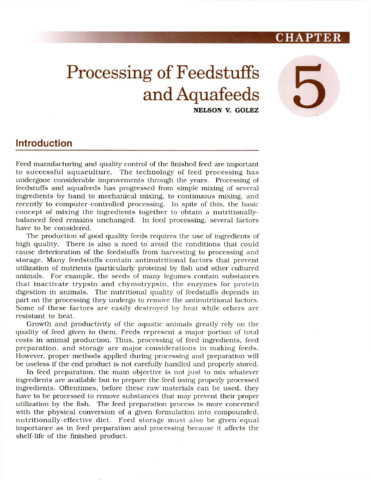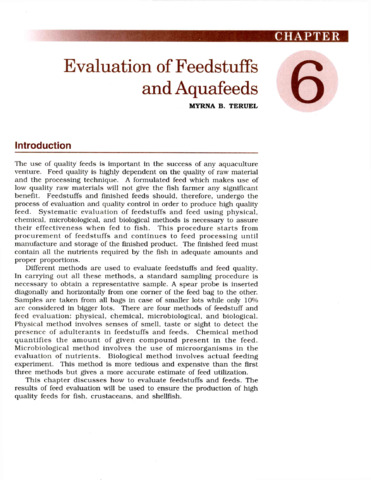បង្ហាញកំណត់ត្រាសាមញ្ញសម្រាប់ធាតុ
Formulation of aquafeeds
Share
| dc.contributor.author | Catacutan, Mae R. | |
| dc.contributor.editor | Millamena, Oseni M. | |
| dc.contributor.editor | Coloso, Relicardo M. | |
| dc.contributor.editor | Pascual, Felicitas P. | |
| dc.date.accessioned | 2018-06-18T09:51:10Z | |
| dc.date.available | 2018-06-18T09:51:10Z | |
| dc.date.issued | 2002 | |
| dc.identifier.citation | Catacutan, M. R. (2002). Formulation of aquafeeds. In O. M. Millamena, R. M. Coloso, & F. P. Pascual (Eds.), Nutrition in Tropical Aquaculture: Essentials of fish nutrition, feeds, and feeding of tropical aquatic species (pp. 99–123). Tigbauan, Iloilo, Philippines: Aquaculture Department, Southeast Asian Fisheries Development Center. | en |
| dc.identifier.isbn | 971851158X | |
| dc.identifier.uri | http://hdl.handle.net/10862/3318 | |
| dc.description.abstract | The development of a feed that is both effective and economical for an aquaculture species in all its life stages is a continuous effort. Aquafeed development started when natural food sources in culture systems became inadequate and had to be supplemented with prepared feed. As fish stocking densities in culture increase, supplemental feeding is no longer sufficient. A complete feed that contains all the necessary nutrients in sufficient amounts to bring about good growth, survival, and reproduction is needed. Feed ingredients generally come from animal or plant sources and some are by-products of the food industry. There is no single feed ingredient or feedstuff that contains all the nutrients in adequate amounts. Thus, different feed ingredients are combined to make a feed that has the desired composition and nutrient levels. In combining various feed ingredients, it is important to know how much of each feed ingredient should be used to produce a cost-effective aquafeed. With the growth and expansion of aquaculture into a major industry, several fish species are being cultured; thus, the development of more efficient aquafeed formulations should continue. In developing cost-effective formulated diets, many important factors have to be considered. This chapter discusses these factors and the mathematical calculations in formulating a feed. It aims to enable students to formulate diets using purified and practical feed ingredients, and also to formulate effective supplemental and complete diets for aquaculture species. | en |
| dc.description.tableofcontents |
| en |
| dc.language.iso | en | en |
| dc.publisher | Aquaculture Department, Southeast Asian Fisheries Development Center | en |
| dc.title | Formulation of aquafeeds | en |
| dc.type | Book chapter | en |
| dc.citation.spage | 99 | |
| dc.citation.epage | 123 | |
| dc.subject.asfa | feeds | en |
| dc.subject.asfa | feeding experiments | en |
| dc.subject.asfa | feed preparation | en |
| dc.subject.asfa | formulae | en |
| dc.subject.asfa | feed composition | en |
| dc.subject.asfa | nutritive value | en |
| dc.subject.asfa | animal nutrition | en |
| dc.subject.asfa | Diets | en |
| dc.subject.asfa | nutritional requirements | en |
| dc.subject.asfa | proteins | en |
| dc.subject.asfa | lipids | en |
| dc.subject.asfa | carbohydrates | en |
| dc.subject.asfa | Fish meal | en |
| dc.subject.asfa | aquaculture techniques | en |
| dc.subject.asfa | aquaculture development | en |
| dc.subject.asfa | aquaculture | en |
| dc.citation.bookTitle | Nutrition in Tropical Aquaculture: Essentials of fish nutrition, feeds, and feeding of tropical aquatic species | en |
ឯកសារសម្រាប់ធាតុនេះ។
| ឯកសារ | ទំហំ | ទម្រង់ | ការរុករក |
|---|---|---|---|
| 3318-CatacutanMR2002.pdf | 4.968មេកាបៃ | application/pdf | រកមើល / បើក |



